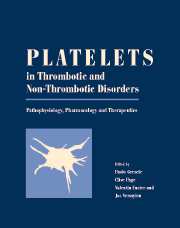Book contents
- Frontmatter
- Contents
- List of contributors
- Editors' preface
- PART I PHYSIOLOGY
- PART II METHODOLOGY
- PART III PATHOLOGY
- PART IV PHARMOLOGY
- 61 Aspirin
- 62 Pharmacology of ticlopidine and clopidogrel
- 63 Platelet membrane glycoprotein (GP) IIb–IIIa antagonists and acute arterial thrombosis
- 64 Other antiplatelet agents
- 65 Pharmacogenetics as a new antiplatelet strategy
- 66 Cardiovascular gene therapy: implications for platelet vessel wall interactions
- 67 Pharmacological modulation of the inflammatory actions of platelets
- PART V THERAPY
- Afterword: Platelets: a personal story
- Index
- Plate section
65 - Pharmacogenetics as a new antiplatelet strategy
from PART IV - PHARMOLOGY
Published online by Cambridge University Press: 10 May 2010
- Frontmatter
- Contents
- List of contributors
- Editors' preface
- PART I PHYSIOLOGY
- PART II METHODOLOGY
- PART III PATHOLOGY
- PART IV PHARMOLOGY
- 61 Aspirin
- 62 Pharmacology of ticlopidine and clopidogrel
- 63 Platelet membrane glycoprotein (GP) IIb–IIIa antagonists and acute arterial thrombosis
- 64 Other antiplatelet agents
- 65 Pharmacogenetics as a new antiplatelet strategy
- 66 Cardiovascular gene therapy: implications for platelet vessel wall interactions
- 67 Pharmacological modulation of the inflammatory actions of platelets
- PART V THERAPY
- Afterword: Platelets: a personal story
- Index
- Plate section
Summary
“At that time two men will be working in a field:
one will be taken away, the other will be left behind.
Two women will be at a mill grinding meal:
one will be taken away, the other will be left behind.”
Mt. 24, 40–41Antiplatelet strategy: a brief historical review
The first three drugs tested in clinical trials for their potential antiplatelet effects were all already used in current practice for different reasons, unrelated to thrombosis and ischemic artery disease.
Aspirin was known as an anti-inflammatory compound, sulfinpyrazone was used for its uricosuric properties and dipyridamole was endowed with vasodilatory (coronarodilatory) effect. Their mechanism of action, as antiplatelet agents, was largely unknown, but the possibility of replacing oral anticoagulants with relatively safer substances, not requiring any laboratory control, convinced many clinicians to adapt an antiplatelet strategy, even before the results of well-planned and conducted clinical trials were made available.
The discovery of the crucial role of prostaglandins and thromboxane A2 (TxA2) in platelet function and of their possibly unselective pharmacological control by aspirin, stimulated for the first time the search for a more rational antiplatelet strategy.
However, the development of selective TxA2-synthase inhibitors, TxA2-receptor antagonists and of compounds endowed with both properties was not followed by the expected clinical results. This was due to several reasons, including the complex re-orientation of platelet arachidonate metabolism following pharmacological suppression of TxA2 synthesis or of its receptor function.
- Type
- Chapter
- Information
- Platelets in Thrombotic and Non-Thrombotic DisordersPathophysiology, Pharmacology and Therapeutics, pp. 964 - 977Publisher: Cambridge University PressPrint publication year: 2002
- 2
- Cited by



